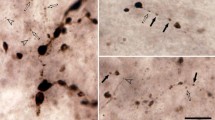Abstract
The effects of restriction of sensory afferentation in rats by vibrissectomy performed daily on days 9 to 20 of life on the formation of defensive reactions in early postnatal ontogenesis were studied. Vibrissectomized and control rat pups were assessed in terms of the extent of motor defensive reactions in response to touching the skin from days 10 to 18 of life, the duration of the freezing reaction at age 20 days, and behavior in the open field at age 25 days. Vibrissectomized rat pups showed the following significant differences from controls: a decrease in the extent of early withdrawal from a potentially dangerous stimulus (at age 12 and 13 days), a decrease in the duration of the freezing reaction, and decreases in that extents of the flight reaction and emotional reactivity in the open field test.
Similar content being viewed by others
References
L. K. Markel’, “Evaluation of the main characteristics of rat behavior in the open field test,” Zh. Vyssh. Nerv. Deyat., 31, No. 2, 301–307 (1981).
A. L. Markel’, Yu. K. Galaktionov, and V. M. Efimov, “Factor analysis of rat behavior in the open field test,” Zh. Vyssh. Nerv. Deyat., 38, No. 5, 855–863 (1988).
V. E. Sokolov and S. A. Kvashnin, The Ontogenesis of Behavior. The Gray Rat [in Russian], V. E. Sokolov et al. (eds.), Nauka, Moscow (1990), pp. 230–254.
S. A. Titov and A. A. Kamenskii, “The role of the orientational and defensive components in the behavior of white rats in ‘open field’ conditions,” Zh. Vyssh. Nerv. Deyat., 30, No. 4, 704–710 (1980).
A. Yu. Shishelova, “Effects of vibrissectomy in early postnatal ontogenesis on the development of defensive behavior in rats,” in: Proceedings of the CIC Congress of the Physiology Society, Ros. Fiziol. Zh., 90, No. 8, 192 (2004).
R. C. Bolles and P. J. Woods, “The ontogeny of behaviour in the albino rat,” Anim. Behav., 12, No. 4, 427–446 (1964).
C. Caldji, B. Tannenbaum, S. Sharma, D. Francis, P. M. Plotsky, and M. J. Meaney, “Maternal care during infancy regulates the development of neural systems mediating the expression of fearfulness in the rat,” Proc. Natl. Acad. Sci. USA, 95, 5335–5340 (1998).
D. V. Chalmers and S. Levine, “The development of heart rate responses to weak and strong shock in the preweaning rats,” Dev. Psychobiol., 7, No. 6, 519–523 (1974).
N. L. Da Silva, V. M. M. Ferreira, A. D. Carobrez, and G. S. Morato, “Individual housing from rearing modifies the performance of young rats on the elevated plus-maze apparatus,” Physioll. Behav., 60, 1391–1395 (1996).
E. Hard, J. Engel, and B. Musi, “The ontogeny of defensive reactions in the rat: influence of the monoamine transmission systems,” Scand. J. Psychol., Suppl. 1, 90–96 (1982).
M. A. Hofer, J. R. Masmela, S. A. Brunelli, and H. N. Shair, “The ontogeny of maternal potentiation of the infant rats isolation call,” Dev. Psychobiol., 33, 189–201 (1998).
S. Levine and R. F. Mullins, “Hormones in Infancy,” in: Early Experience and Behavior. The Psychobiology of Development, G. Newton and S. Levine (eds.), Plenum, New York (1971), pp. 142–168.
M. Maravall, E. A. Stern, and K. Svaboda, “Development of intrinsic properties and excitability of layer 2/3 pyramidal neurons during a critical period for sensory maps in rat barrel cortex,” J. Neurophysiol., 92, 144–156 (2004).
R. Melzack, “Early experience: a neurophysiological approach to heredity-environment interactions,” in: Early Experience and Behavior. The Psychobiology of Development, G. Newton and S. Levine (eds.), Plenum, New York (1971), pp. 142–165.
W. H. Moorcroft, L. D. Lytle, and B. A. Campbell, “Ontogeny of starvation-induced behavioral arousal in the rat,” J. Comp. Physiol. Psychological., 75, No. 1, 59–67 (1971).
S. Moriceau, T. L. Roth, T. Okotoghaide, and R. M. Sullivan, “Corticosterone controls the developmental emergence of fear and amygdale function to predator odors in infant rat pups,” Int. J. Dev. Neurosci., 22, No. 5–6, 415–422 (2004).
P. A. Russel, “Relationships between exploratory behavior and fear: a review,” Brit. J. Psychological., 64, No. 3, 417–421 (1973).
R. M. Sullivan, M. S. Landers, J. Flemming, C. Vaught, T. A. Young, and P. H. Jonathan, “Characterizing the functional significance of the neonatal rat vibrissae prior to the onset of whisking,” Somatosens. Mot. Res., 20, 157–162 (2003).
L. K. Takahashi, “Ontogeny of behavioral inhibition induced by unfamiliar adult male conspecifics in preweanling rats,” Physiol. Behav., 52, 493–496 (1992).
L. K. Takahashi and W. W. Rubin, “Corticosteroid induction of threat-induced behavioral inhibition in preweanling rats,” Behav. Neurosci., 107, No. 5, 860–866 (1993).
C. P. Wiedenmayer and G. A. Barr, “Developmental changes in responsivity to threat are stimulus-specific in rats,” Dev. Psychobiol., 39, 1–5 (2001).
Author information
Authors and Affiliations
Additional information
__________
Translated from Zhurnal Vysshei Nervnoi Deyatel’nosti imeni I. P. Pavlova, Vol. 55, No. 5, pp. 677–683, September–October, 2005.
Rights and permissions
About this article
Cite this article
Shishelova, A.Y. Effect of whisker removal on defensive behavior in rats during early ontogenesis. Neurosci Behav Physiol 36, 883–888 (2006). https://doi.org/10.1007/s11055-006-0102-0
Received:
Accepted:
Issue Date:
DOI: https://doi.org/10.1007/s11055-006-0102-0



